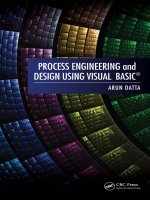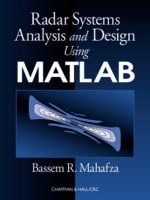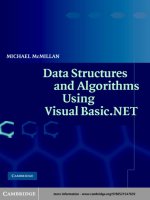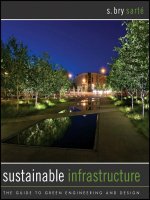process engineering and design using visual basic
Bạn đang xem bản rút gọn của tài liệu. Xem và tải ngay bản đầy đủ của tài liệu tại đây (18.65 MB, 474 trang )
Half title page
PROCESS ENGINEERING and
DESIGN USING VISUAL BASIC
®
45423_C000.fm Page i Monday, August 27, 2007 11:16 AM
45423_C000.fm Page ii Monday, August 27, 2007 11:16 AM
Title Page
CRC Press is an imprint of the
Taylor & Francis Group, an informa business
Boca Raton London New York
ARUN DATTA
PROCESS ENGINEERING and
DESIGN USING VISUAL BASIC
®
45423_C000.fm Page iii Monday, August 27, 2007 11:16 AM
Visual Basic and Excel are registered trademarks of Microsoft.
CRC Press
Taylor & Francis Group
6000 Broken Sound Parkway NW, Suite 300
Boca Raton, FL 33487-2742
© 2008 by Taylor & Francis Group, LLC
CRC Press is an imprint of Taylor & Francis Group, an Informa business
No claim to original U.S. Government works
Printed in the United States of America on acid-free paper
10 9 8 7 6 5 4 3 2 1
International Standard Book Number-13: 978-1-4200-4542-0 (Hardcover)
is book contains information obtained from authentic and highly regarded sources. Reprinted
material is quoted with permission, and sources are indicated. A wide variety of references are
listed. Reasonable efforts have been made to publish reliable data and information, but the author
and the publisher cannot assume responsibility for the validity of all materials or for the conse-
quences of their use.
No part of this book may be reprinted, reproduced, transmitted, or utilized in any form by any
electronic, mechanical, or other means, now known or hereafter invented, including photocopying,
microfilming, and recording, or in any information storage or retrieval system, without written
permission from the publishers.
For permission to photocopy or use material electronically from this work, please access www.
copyright.com ( or contact the Copyright Clearance Center, Inc. (CCC)
222 Rosewood Drive, Danvers, MA 01923, 978-750-8400. CCC is a not-for-profit organization that
provides licenses and registration for a variety of users. For organizations that have been granted a
photocopy license by the CCC, a separate system of payment has been arranged.
Trademark Notice: Product or corporate names may be trademarks or registered trademarks, and
are used only for identification and explanation without intent to infringe.
Library of Congress Cataloging-in-Publication Data
Datta, Arun.
Process engineering and design using Visual BASIC / Arun Datta.
p. cm.
Includes bibliographical references and index.
ISBN-13: 978-1-4200-4542-0 (alk. paper)
ISBN-10: 1-4200-4542-3 (alk. paper)
1. Chemical processes Mathematical models. 2. Chemical
processes Computer simulation. 3. Microsoft Visual BASIC. I. Title.
TP155.7.D36 2006
660’.28 dc22 2006103307
Visit the Taylor & Francis Web site at
and the CRC Press Web site at
45423_C000.fm Page iv Monday, August 27, 2007 11:16 AM
Dedication
To my mother
Smt. Narayani Datta
45423_C000.fm Page v Monday, August 27, 2007 11:16 AM
45423_C000.fm Page vi Monday, August 27, 2007 11:16 AM
vii
Contents
Chapter one Basic mathematics 1
Introduction 1
Physical constants 1
SI prefixes 1
Mensuration 2
Triangles 2
Rectangles 2
Parallelogram (opposite sides parallel) 3
Rhombus (equilateral parallelogram) 3
Trapezoid (four sides, two parallel) 3
Quadrilateral (four sided) 4
Regular polygon of
n
sides 4
Circle 4
Ellipse 6
Parabola 6
Prism 6
Pyramid 7
Right circular cylinder 7
Sphere 7
Right circular cone 8
Dished end 8
Irregular shape 8
Trapezoidal rule 8
Simpson’s rule 8
Irregular volume 9
Algebra 9
Factoring 9
Arithmetic progression 9
Geometric progression 10
Infinite series (in GP) 10
Best fit straight line (least squares method) 10
Binomial equation 11
Polynomial equation 11
45423_C000.fm Page vii Monday, August 27, 2007 11:16 AM
viii Process engineering and design using Visual Basic
Maxima/minima 12
Matrix 13
Addition and multiplication of matrices 13
Addition of matrices 14
Multiplication of matrices 14
Matrix properties involving addition 14
Matrix properties involving multiplication 15
Matrix properties involving addition and multiplication 15
Transpose 15
Symmetric matrix 16
Diagonal matrix 16
Determinants 16
Properties of determinants 17
Cofactor 18
Determinant and inverses 19
Adjoint 19
Cramer’s rule 20
Trigonometry 21
Functions of circular trigonometry 21
Periodic functions 22
The magic identity 22
The addition formulas 23
Double angle and half angle 23
Product and sum formulas 24
Relations between angles and sides of triangles 25
Law of sines 26
Law of tangents 26
Law of cosines 26
Other relations 26
Inverse trigonometric functions 27
Hyperbolic functions 28
Other hyperbolic functions 29
Inverse hyperbolic functions 29
Analytical geometry 30
Straight line 30
Straight line through two points 30
Three points on one line 31
The circle 31
Tangent 31
Normal 32
Four points on a circle 32
Circle through three points 33
Conic section 33
Focus 33
Eccentricity 33
Directrix 33
45423_C000.fm Page viii Monday, August 27, 2007 11:16 AM
Contents ix
Partial derivatives 33
Parabola 34
Tangent line with a given slope,
m
36
Ellipse 36
Hyperbola 38
Calculus 40
Differential calculus 40
Understanding the derivatives 41
Standard derivatives 42
Integral calculus 44
Volume of horizontal dished end 44
Volume of vertical dished end 46
Standard integrals 47
Differential equations 48
First-order differential equations 48
Separation of variables 49
Second-order differential equations 50
Bessel function 51
Partial differential equations 52
Laplace transform 60
Standard Laplace transforms 61
Fourier half-range expansions 62
Fourier half-range cosine series 63
Fourier half-range sine series 63
Numerical analysis 65
Solving linear equations (Newton’s method) 65
Newton’s method in two variables 66
Numerical methods in linear algebra 68
Gauss elimination 68
Cholesky method 70
Numerical integration 72
Trapezoidal rule 72
Simpson’s rule 72
Double integration using Simpson’s rule 75
Numerical solution of first-order differential equations 76
Euler’s method 76
Improved Euler’s method 76
Runge–Kutta method 77
Second-order differential equations 79
Runge–Kutta–Nystrom method 79
Partial differential equations 81
Heat conduction problem 81
Numerical solution 83
Alternating direction implicit (ADI) method 85
Equation of state 90
Boyle’s law and Charles’ law 90
45423_C000.fm Page ix Monday, August 27, 2007 11:16 AM
x Process engineering and design using Visual Basic
Equation of state for real gas 92
Comparison between Peng–Robinson and SRK EOSs 92
Acentric factor 94
Vapor pressure of pure components 94
SRK EOS 94
PR EOS 97
Alternate method to estimate vapor pressure of pure
components 97
Vapor pressure of pure water 98
Equilibrium ratio (
K
) 98
Mixing rules 99
Estimate fugacity coefficient of vapor 101
Influence of interaction coefficient 102
Estimation of dew point 102
Unit conversions 103
Programming 103
General notes for all programmers
Vessel 103
Program limitations 103
Horizontal 108
Data entry 108
Inclined 110
Vertical 111
Conversion 112
Program limitations 114
Procedure 114
References/further reading 114
Chapter two Fluid mechanics 117
Introduction 117
Bernoulli’s theorem 118
Velocity heads 119
Flow measurements 120
Orifice/Venturi meter 120
Thermal expansion factor (
F
a
) 122
Coefficient of discharge
C
D
122
Orifice meter 122
Restriction orifice 123
Venturi meter 124
Expansion factor (
Y
) 124
Orifices 124
Nozzles and Venturi 124
Nonrecoverable pressure drop 124
Orifices 125
Venturi with 15
°
divergent angle 125
Venturi with 7
°
divergent angle 125
45423_C000.fm Page x Monday, August 27, 2007 11:16 AM
Contents xi
Critical flow 125
Area meter: rotameters 125
Flow through an open channel 126
V notch 126
Rectangular notch 127
Frictional pressure drop 127
Darcy equation 127
Flow in open channel 128
Estimation of friction factor 129
Friction factor — laminar flow 129
Friction factor — turbulent flow 129
Two-K method 130
K for reducer/expander 130
Reducer 130
Expander 132
Pipe entrance 132
Pipe exit 132
Split flow 132
Split 1,3 133
Split 1,2 133
Split 3,1 134
Split 1,2,3 134
Split 1,3,2 134
Split 3,1,2 134
Hydraulics — general guidelines 134
Roughness of pipe wall 135
Control valve CV 135
Line sizing criteria for liquid lines 136
Line sizing for gravity flow lines 136
Downpipe sizing 136
Line sizing criteria for vapor lines 137
Relief valve inlet line sizing 137
Relief valve outlet line sizing 138
Line sizing criteria for two-phase flow 138
Hydraulics — compressible fluids 139
Adiabatic flow in a pipe 139
Isothermal flow in a pipe 142
Heat loss 143
Types of cross-country buried pipelines 143
Yellow jacket 143
Coating thickness 143
Fusion-bonded epoxy coating 144
Rate of heat transfer 144
Film resistance (
R
film
) 144
Resistance of pipe (
R
pipe
) 146
Resistance of coatings (
R
coating
) 146
45423_C000.fm Page xi Monday, August 27, 2007 11:16 AM
xii Process engineering and design using Visual Basic
Resistance of environment (
R
env
) 147
Viscosity of water 149
Thermal conductivity of water 149
Viscosity of air 150
Thermal conductivity of air 150
Choked flow 150
Limiting differential pressure 151
Limiting expansion factor
Y
151
Hydraulics — two-phase flow 153
Beggs and Brill correlations 155
Step 1: Estimation of flow regime 155
Step 2: Estimation of horizontal holdup 155
Step 3: Estimation of uphill holdup 156
Step 4: Estimation of downhill holdup 156
Step 5: Estimation of friction factor 157
Step 6: Estimation of pressure drop 157
Mukherjee and Brill correlations 158
Step 1: Estimation of flow regime 158
Step 2: Estimation of holdup 160
Step 3: Estimation of hydrostatic head 160
Step 4: Estimation of acceleration head 160
Step 5: Estimation of friction factor 161
Step 6: Estimation of frictional pressure drop 161
CO
2
corrosion 164
CO
2
corrosion mechanism 164
NACE requirements 165
Rate of corrosion 165
Constant
K
t
165
Fugacity of CO
2
166
Calculation of pH factor
f
(pH) 167
Calculation of shear stress 168
Effect of temperature 169
Effect of glycol 170
Effect of corrosion inhibitor 170
Condensation factor 170
Programming 171
Program for flow elements 171
General overview 171
Project details 172
Calculation form 172
Program limitations and notes 173
Program for hydraulic calculations 176
General overview 177
Project details 177
Program limitations and notes 178
Form incompressible fluid 178
45423_C000.fm Page xii Monday, August 27, 2007 11:16 AM
Contents xiii
Form compressible fluid 181
Pressure drop comparison 184
Form for two-phase flow 184
Horizontal pipe section 187
Uphill pipe section 188
Downhill pipe section 190
General conclusion 192
Program for corrosion calculations 192
Program limitations and notes 193
Calculation of pH 193
Nomenclature 197
Greek characters 200
References 200
Chapter three Separators 203
Introduction 203
General principles of separation 203
Droplet in a vertical vessel 203
Droplet in a horizontal vessel 206
Gravity settling: limiting conditions 206
Newton’s law 207
Stoke’s law 207
Intermediate law 207
Critical particle diameter 207
Vertical vs. horizontal separators 208
Advantages of the horizontal separator 209
Disadvantages of the horizontal separator 209
Advantages of the vertical separator 209
Disadvantages of the vertical separator 209
Design of a gas–liquid separator 209
Critical settling velocity 209
Design constant
K
D
210
API 521 method 211
Design of liquid–liquid separators 212
Mist eliminator 214
Wire mesh mist eliminator 214
Efficiency of the mist eliminator 214
Target collection efficiency 215
Inertial impaction 215
Direct interception 215
Diffusion 215
Target collection efficiency 216
Pressure drop of mist eliminator 216
Vane type mist eliminator 217
Efficiency of vane pack 217
Terminal centrifugal velocity 217
45423_C000.fm Page xiii Monday, August 27, 2007 11:16 AM
xiv Process engineering and design using Visual Basic
Pressure drop through the vane pack 218
General dimensions and setting of levels 219
The horizontal separator 219
Boot 221
Vertical separator 222
Separator internals 223
The inlet nozzle 223
The vortex breaker 224
Separator control 224
Pressure and flow control 226
Light liquid level control 226
Heavy liquid level and slug control 226
High performance separator 226
Salient features of GLCC 228
Design parameters 228
Flow rates 228
Slug length 228
Density 230
Viscosity 231
Oil in gas droplet size 232
Oil in water droplet size 232
Water in oil droplet size 233
Inlet nozzle velocity 233
Gas outlet nozzle velocity 233
Liquid outlet velocity 233
Separator program 233
Program limitations/notes 234
Horizontal separators 234
Three-phase flooded weir 234
Three-phase nonflooded-weir separator 234
Three-phase with boot separator 234
Two-phase vapor–liquid separator 234
Two-phase liquid–liquid separator 235
Vertical separators 235
Two-phase vapor–liquid separator 235
Two-phase liquid–liquid separator 235
General overview of the separator.exe program 235
Design 240
Nomenclature 244
Greek characters 245
References 246
Chapter four Overpressure protection 247
Introduction 247
Impact on plant design 247
Impact on individual design 248
45423_C000.fm Page xiv Monday, August 27, 2007 11:16 AM
Contents xv
Definition 248
Accumulation 248
Atmospheric discharge 249
Built-up back pressure 249
General back pressure 249
Superimposed back pressure 249
Balanced-bellows PRV 250
Blowdown 250
Closed discharge system 250
Cold differential test pressure 250
Conventional PRV 250
Design capacity 250
Design pressure 250
Maximum allowable accumulated pressure 251
Maximum allowable working pressure 251
Operating pressure 251
Overpressure 251
Pilot-operated PRV 251
Pressure relief valve (PRV) 252
Pressure safety valve 252
Rated relieving capacity 252
Relief valve 252
Relieving conditions 252
Rupture disk 252
Safety relief valve 252
Safety valve 253
Set pressure 253
Vapor depressuring system 253
Vent stack 253
Types of pressure relief valves 254
Conventional pressure relief valve (vapor service) 254
Conventional pressure relief valve (liquid service) 256
Balanced-bellows pressure relief valve 256
Pilot-operated pressure relief valve 259
Rupture disk 262
Selection of pressure relief valves 262
Conventional pressure relief valve 262
Balanced-bellows pressure relief valve 264
Pilot-operated pressure relief valve 264
Rupture disk 265
PRV installation and line sizing 265
Compressors and pumps 265
Fired heaters 266
Heat exchangers 267
Piping 267
Pressure vessels 267
45423_C000.fm Page xv Monday, August 27, 2007 11:16 AM
xvi Process engineering and design using Visual Basic
PRV isolation valves 268
Inlet piping to PRVs 270
Discharge piping from PRVs 271
Contingency quantification 272
General 272
Power failure 273
Local power failure 274
Failure of a distribution center 274
Total power failure 275
Cooling water failure 275
Instrument air failure 276
Steam failure 277
Total steam failure 278
Loss of steam to specific equipment 278
Partial steam failure 278
Check valve failure 278
Blocked outlet 279
Pump or compressor discharge 279
Multiple outlet 280
Block valve downstream of control valve 280
Control valve failure 280
Vapor breakthrough 281
Maximum flow 283
Thermal relief 283
Modulus of elasticity of pipe material (
E
) 286
Coefficient of linear thermal expansion (
α
) 286
Valve leakage rate (
q
) 287
Compressibility of liquid (
Z
) 288
Coefficient of cubic expansion of liquids (
β
) 288
Installation of thermal relief valve 288
Fire exposure 289
General guidelines 290
Estimation of wetted surface area 290
Fire circle 292
Estimation of latent heat and physical properties 292
Liquid wet vessel 293
Vessels with only gas 295
Two liquid phases 296
Heat exchanger tube rupture 298
Contingency calculation 299
Reflux failure and overhead system 302
Loss of reboiler heat 303
Venting of storage tank 303
Venting due to liquid movements 304
Thermal venting 304
45423_C000.fm Page xvi Monday, August 27, 2007 11:16 AM
Contents xvii
Fire exposure 304
Minimum flow area 304
Sizing procedure 307
Sizing of liquid relief 307
Sizing of vapor relief 309
Critical flow 309
Subcritical flow 311
Conventional and pilot-operated PRV 311
Balanced-bellows PRV 311
Sizing for steam relief 311
Sizing for two-phase fluids 313
Design of flare stack 330
Minimum distance 330
Fraction of heat intensity transmitted,
τ 331
Fraction of heat radiated,
F
331
Heat release,
Q
332
Sizing of a flare stack: simple approach 332
Calculation of stack diameter 332
Calculation of flame length 333
Flame distortion caused by wind velocity 333
Sizing of flare stack: Brzustowski and Sommer approach 335
Calculation of flare stack diameter 335
Location of flame center
x
c
,
y
c
335
Lower explosive limit of mixtures 335
Vertical distance
y
c
338
Horizontal distance
x
c
338
SIL analysis 343
Definitions 344
Diagnostic coverage (DC) 344
Final element 344
MooN 344
Programmable electronics (PE) 344
Programmable electronic system (PES) 344
Protection layer 344
Safety-instrumented function (SIF) 344
Safety-instrumented systems (SIS) 345
Safety integrity 345
Safety integrity level (SIL) 345
Safety life cycle 345
Matrix for SIL determination 345
Probability of failure on demand 347
ALARP model 348
Determination of SIL 348
Financial 350
Health and safety 351
Environment and asset 351
45423_C000.fm Page xvii Monday, August 27, 2007 11:16 AM
xviii Process engineering and design using Visual Basic
Programming 353
Program for pressure relief valve 353
Program limitations and notes 353
General overview 354
Project details 355
File save 355
File open 355
File print 355
Exit 355
Specific message or warning: back pressure 355
Back-pressure correction factor 356
Pilot-operated PRV 356
Liquid 357
Vapor 357
Two-phase type 1 and type 2 calculations 357
Program for flare stack estimation 362
Program limitations and notes 363
Specific message/warning 364
Nomenclature 365
Greek characters 366
References 366
Chapter five Glycol dehydration 369
Introduction 369
Basic scheme 370
Advantages 370
Disadvantages 370
Pre-TEG coalescer 370
Contactor 370
Flash separator 372
Filters 372
Pumping 372
Glycol/glycol exchanger 373
Gas/glycol exchanger 373
Regenerator 373
Physical properties 374
Selection of type of glycol 374
Common properties of glycol 374
Densities of aqueous glycol solutions 376
Solubility of various compounds 376
Fire hazard information 376
Viscosities of aqueous glycol solutions 381
Specific heats of aqueous glycol solutions 385
Thermal conductivities of aqueous glycol solutions 387
Design aspects 389
Water content in hydrocarbon gas 389
45423_C000.fm Page xviii Monday, August 27, 2007 11:16 AM
Contents xix
Equilibrium dew point 389
Minimum lean-TEG concentration 389
Number of theoretical stages of the contactor 391
Design of contactor 394
Type of internals 394
Flash separator 397
Filters 397
Particulate filter 398
Carbon filter 398
Glycol/glycol exchanger 398
Gas/glycol exchanger 398
Regenerator 400
Still column 402
Reboiler 403
Fire tube heat density 403
Fire tube heat flux 403
Lean glycol storage 404
Energy exchange pump 404
Burner management 406
Specifications 412
Programming 415
Program limitations 415
General overview 416
File menu 416
Unit menu 417
Project details 417
Data entry 417
References 418
Index 419
45423_C000.fm Page xix Monday, August 27, 2007 11:16 AM
45423_C000.fm Page xx Monday, August 27, 2007 11:16 AM
xxi
Preface
The availability of various design tools and software made process engineer-
ing and design simple but also, in some cases, paradoxically led to inade-
quate design. Unfortunately, not only young engineers but also reasonably
experienced engineers are becoming more dependent on software tools with-
out having a basic understanding of the design. I have seen people using
HYSYS
®
to estimate water boiling temperature at atmospheric pressure. This
reduced self-confidence is the key factor for inappropriate process design in
many cases.
As everything in process design can’t be covered by software tools like
HYSYS
®
, HTRI
®
, etc., most design/consulting groups have developed their
own design tools mostly using Excel
®
spreadsheets. Excel spreadsheets are
extremely easy to develop and easy to corrupt through cut-and-paste mod-
ifications as well as with attempts to modify the macros of the spreadsheet.
Sometimes we also failed to recognize the limitations of Excel spreadsheets
and develop something that does not produce the intended output.
In spite of different procedures and design tools, we sometimes come
across some typical design requirements that are not covered by any known
procedure. Some understanding of basic mathematics and fundamental pro-
cess engineering can solve a large number of problems without much diffi-
culty. For example, a volume calculation of a horizontal vessel requires
simple integration, volume calculation of an inclined vessel using Simpson’s
rule, etc.
The main purpose of this work is to identify small but important issues
we normally come across during design and the best possible procedures
to resolve them. This work gives a detailed analysis of the methodology
used for a particular calculation and in some cases limitations of the proce-
dure. This is done so that the user can check a calculation manually and
develop an understanding of the basic design. This will improve the self-
confidence of the user.
The programs have been developed in Visual Basic
®
to avoid limitations
of other programming tools, e.g., Excel. All programs have been developed
to use both the International System of Units (SI) and English units (the
45423_C000.fm Page xxi Monday, August 27, 2007 11:16 AM
xxii Process engineering and design using Visual Basic
default choice is SI); however, the programs do not allow changing of indi-
vidual units.
Though each program has been checked extensively for correctness, the
possibility of program bugs can’t be totally eliminated. Any feedback on
program malfunctioning will be highly appreciated, as well as any other
comments to improve future editions.
Arun K. Datta
45423_C000.fm Page xxii Monday, August 27, 2007 11:16 AM
xxiii
Acknowledgements
I wish to express my gratitude to WorleyParsons, Brisbane, for their strong
support while this work was being produced. Special thanks go to my wife,
Dr. Nivedita Datta, and my daughter, Raka Datta, whose support and
encouragements were the key factors in the completion of this work. I am
also very grateful to Malcolm Rough of WorleyParsons for his full review
of the manuscript and many useful suggestions. I also appreciate the
encouragement I have received from my mentors over many years, partic-
ularly Tony Buckley and Ivan Broome of WorleyParsons. I have tried my
best to thoroughly utilize my learning from them.
I also acknowledge the help received from the American Petroleum
Institute, the Gas Processors Suppliers Association, and John M. Campbell
and Company for allowing me to publish their relevant figures and tables.
Special thanks are also due to the editorial and production staff of CRC Press,
a Taylor & Francis Company, particularly Allison Shatkin, Marsha Pronin,
and Ari Silver for publishing this work with outstanding quality.
I will thankfully acknowledge any suggestion to further improve future
editions.
Arun K. Datta
Brisbane, Australia
45423_C000.fm Page xxiii Monday, August 27, 2007 11:16 AM
45423_C000.fm Page xxiv Monday, August 27, 2007 11:16 AM









